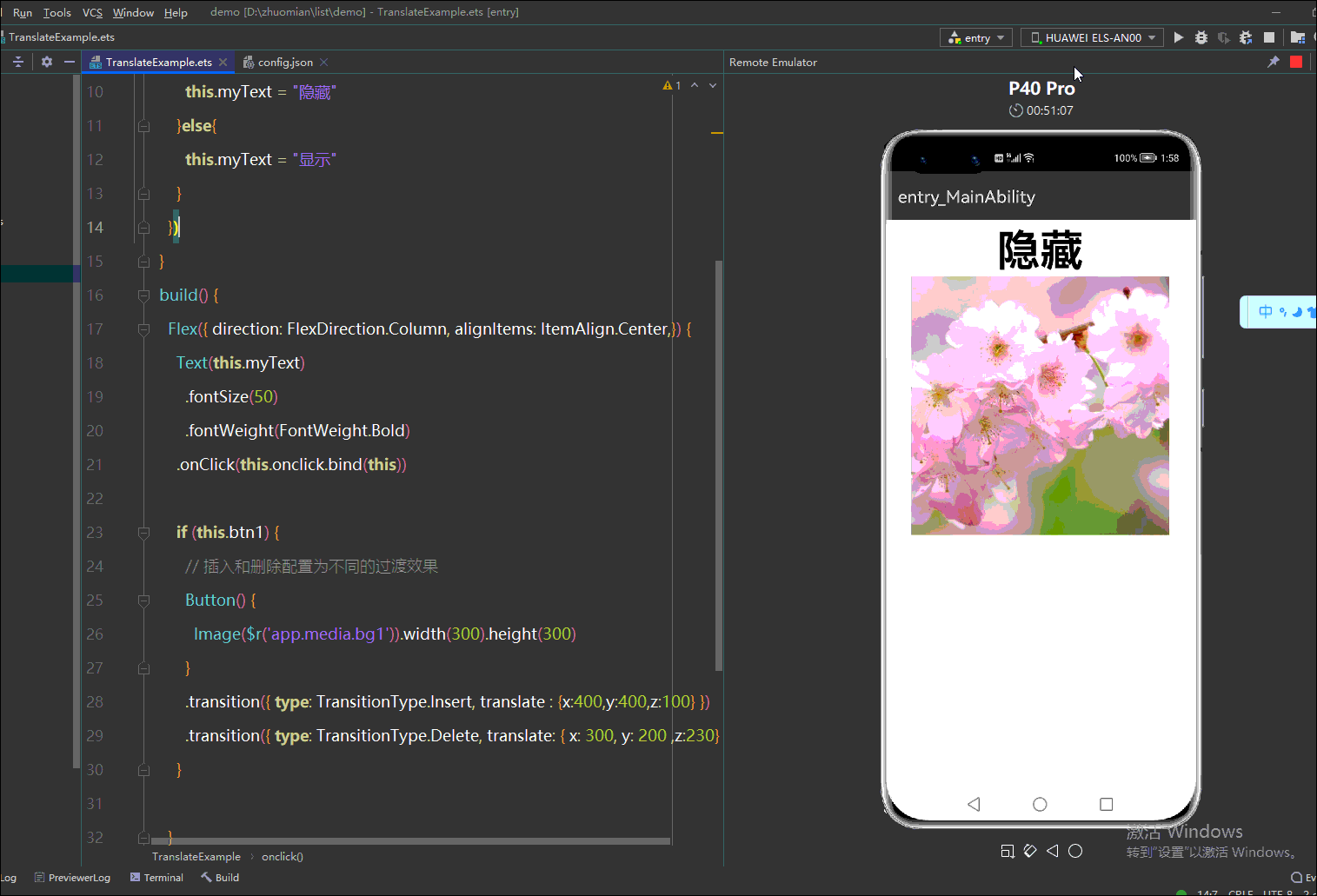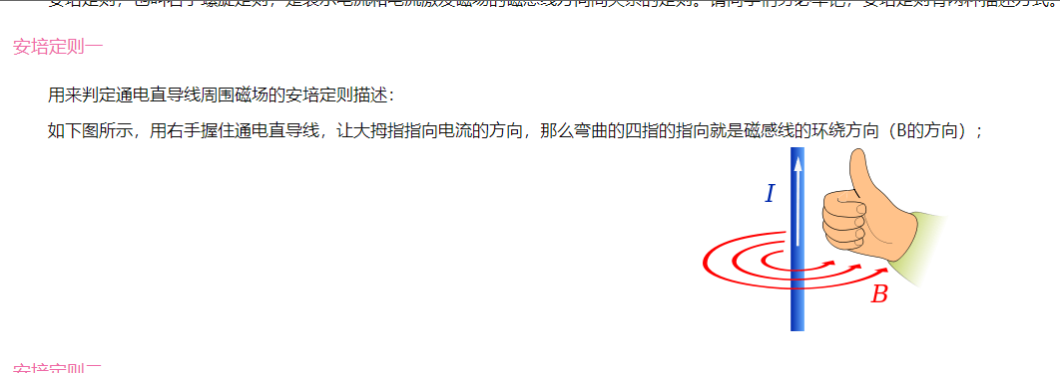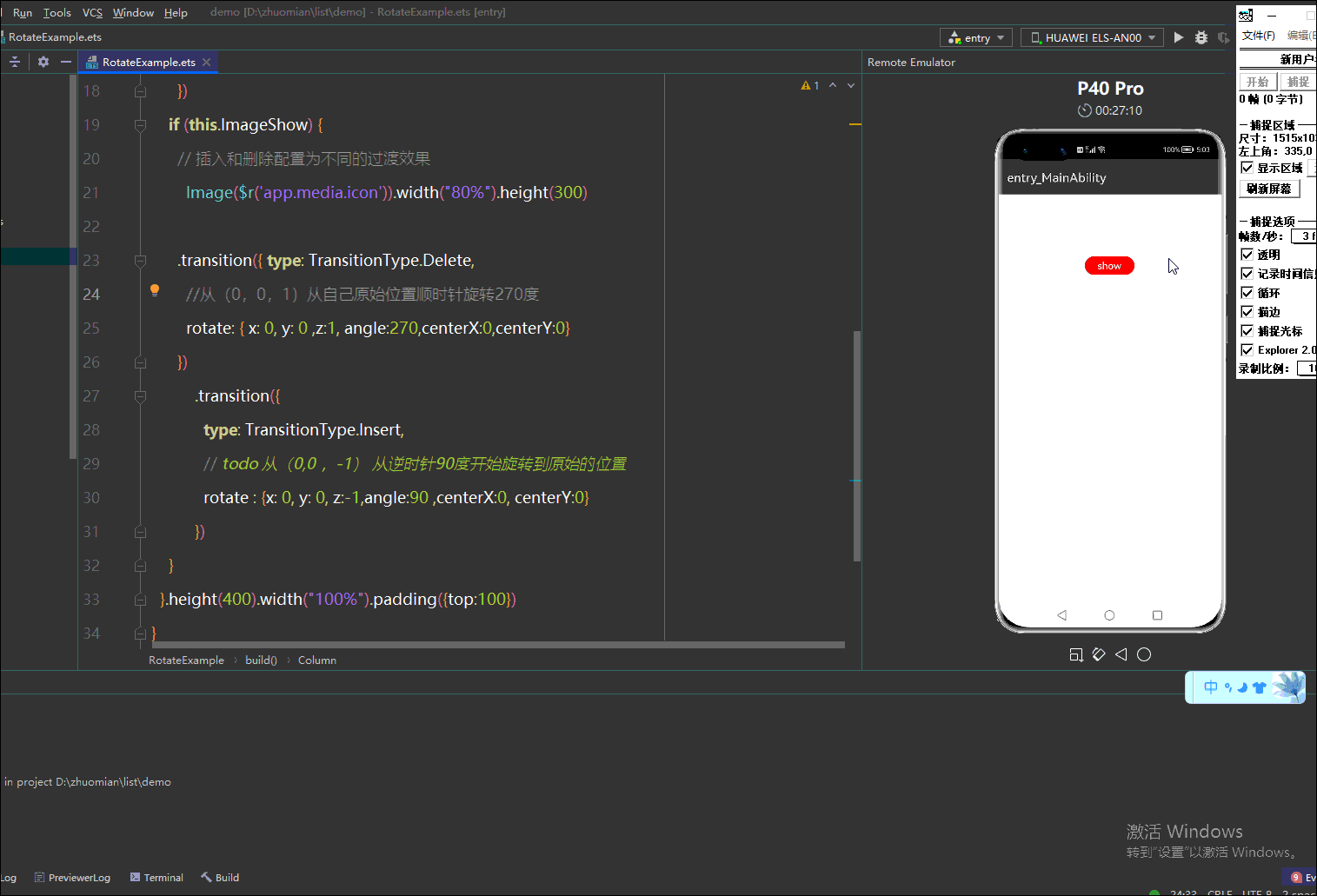【Harmony OS】【ARK UI】组件内转场api 基本使用
说明
从 API Version 7 开始支持。后续版本如有新增内容,则采用上角标单独标记该内容的起始版本。
组件转场主要通过transition属性进行配置转场参数,在组件插入和删除时进行过渡动效,主要用于容器组件子组件插入删除时提升用户体验(需要配合animateTo才能生效,动效时长、曲线、延时跟随animateTo中的配置)。
属性
| 名称 | 参数类型 | 默认值 | 参数描述 |
|---|---|---|---|
| transition | Object | - | 所有参数均为可选参数,详细描述见transition入参说明 |
transition入参说明
| 参数名称 | 参数类型 | 默认值 | 必填 | 参数描述 |
|---|---|---|---|---|
| type | TransitionType | All | 否 | 默认包括组件新增和删除。说明不指定Type时说明插入删除使用同一种效果。 |
| opacity | number | 1 | 否 | 设置组件转场时的透明度效果,为插入时起点和删除时终点的值。 |
| translate | {x? : number,y? : number,z? : number} | - | 否 | 设置组件转场时的平移效果,为插入时起点和删除时终点的值。 |
| scale | {x? : number,y? : number,z? : number,centerX? : number,centerY? : number} | - | 否 | 设置组件转场时的缩放效果,为插入时起点和删除时终点的值 |
| rotate | {x?: number,y?: number,z?: number,angle?: Angle,centerX?: Length,centerY?: Length} | - | 否 | 设置组件转场时的旋转效果,为插入时起点和删除时终点的值。 |
TransitionType枚举说明
| 名称 | 描述 |
|---|---|
| All | 指定当前的Transition动效生效在组件的所有变化场景。 |
| Insert | 指定当前的Transition动效生效在组件的插入场景。 |
| Delete | 指定当前的Transition动效生效在组件的删除场景。 |
示例
示例功能通过一个Button控制第二个Button的出现和消失,并通过transition配置第二个Button出现和消失的过场动画。
补充说明
scale 参数说
| 参数名 | 类型 | 必填 | 默认值 | 说明 |
|---|---|---|---|---|
| x | number | 否 | 1 | x轴的缩放倍数。 |
| y | number | 否 | 1 | y轴的缩放倍数。 |
| z | number | 否 | 1 | z轴的缩放倍数。 |
| centerX | number | string | 否 | 0 | 变换中心点x轴坐标。 |
| centerY | number | string | 否 | 0 | 变换中心点y轴坐标。 |
scale : {x:0,y:1.0,centerX:100,centerY:250}描述 从该逐渐从x轴从无到有,y轴没有扩展,从(100,250)点进去扩展
scale : {x:1,y:0,centerX:100,centerY:250}描述 从该逐渐从x轴没有扩展,y从原有的高度变无 从(100,250)点进去扩展
translate 简单实用
示例代码
运行效果
总结:transition({ type: TransitionType.Insert, translate : {x:400,y:400,z:100} })的意思
进场的时候从x轴400 y轴400 z轴100 平移到x轴0 y轴 z轴0的位置 (就是自身的位置)
transition({ type: TransitionType.Delete, translate: { x: 300, y: 200 ,z:230} })的意思
当type为TransitionType.Delete的时候,退场就是从x轴0y轴0 z周0 平移到 x轴300 y轴300 z轴230的坐标消失
rotate简单实用
rotate参数说明
| 参数名 | 类型 | 必填 | 默认值 | 说明 |
|---|---|---|---|---|
| x | number | 否 | 0 | 旋转向量 |
| y | number | 否 | 0 | 旋转向量 |
| z | number | 否 | 0 | 旋转向量 |
| centerX | number | string | 否 | 不填的话默认是该组件的中心点 | 旋转x轴的中心点 |
| centerY | number | string | 否 | 不填的话默认是该组件的中心点 | 旋转Y轴的中心点 |
| angle | number | string | 否 | 0 | 旋转角度 |
示例代码
如下图所示,我们使用是左手,不是右手切记
效果如下
总结
如上图安培定律所示左手大拇指的方向就是z的方向(0,0,-1)安装当前的桌面水平向右为x轴正方向水平向下为y轴正方向,z轴负方向就是大拇指向量,左手大拇指的方式是面向手机屏幕背面的,我们可以发现四指握旋方向是逆时针,
rotate : {x: 0, y: 0, z:-1,angle:90 ,centerX:0, centerY:0} ,其中90度,那就是从顺时针90运动原始的位置
rotate: { x: 0, y: 0 ,z:1, angle:270,centerX:0,centerY:0} (0,0,1)同样的道理,左手大拇指的方向是面向屏幕的方向的,此时四指握旋方向是顺时针,然后在旋转270后消失










【推荐】国内首个AI IDE,深度理解中文开发场景,立即下载体验Trae
【推荐】编程新体验,更懂你的AI,立即体验豆包MarsCode编程助手
【推荐】抖音旗下AI助手豆包,你的智能百科全书,全免费不限次数
【推荐】轻量又高性能的 SSH 工具 IShell:AI 加持,快人一步
· 全程不用写代码,我用AI程序员写了一个飞机大战
· MongoDB 8.0这个新功能碉堡了,比商业数据库还牛
· 记一次.NET内存居高不下排查解决与启示
· DeepSeek 开源周回顾「GitHub 热点速览」
· 白话解读 Dapr 1.15:你的「微服务管家」又秀新绝活了
2021-08-05 云空间服务,助力用户数据存储与协同
2021-08-05 Input组件无点击效果
2020-08-05 【有奖众测】我有礼品,你有快服务吗?